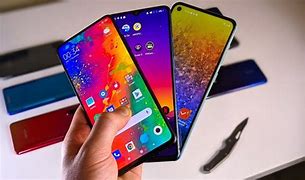Apple offers two iPhones with prices starting at under $500: The $499 iPhone 11 (which is now two generations old) and the $429 third-generation iPhone SE, which was just released. You may be enticed to purchase the new iPhone SE… It’s newer, less expensive, and has a faster processor, after all.
- Size Differences Between iPhone SE and iPhone 11
Although the iPhone 11 is a larger phone, it isn’t what most people would consider “big” by today’s standards. The iPhone SE has a smaller body and is easier to hold, but the display is much smaller due to the large bezels above and below it.
The iPhone 11 is a half-inch taller and a third of an inch wider than the iPhone SE, but the display is 6.1 inches rather than 4.7 inches on the iPhone SE. There is a significant difference in screen size. It’s a matter of personal preference whether you prefer a small phone with a small screen, but you should look at them both in person to help you decide.
Both displays are LCDs with similar specifications.
- Colors on the iPhone SE vs. the iPhone 11
White (“Starlight”), black (“Midnight”), and ProductRED are the three colors available for the iPhone SE, while the iPhone 11 is available in six colors: white, black, ProductRED, purple, yellow, and green.
All of the colors are the same as the iPhone SE, plus three more. There’s only one winner here if you like variety.
- Processor and Specs Comparison: iPhone SE vs iPhone 11
Hands down, the iPhone SE has a superior processor. The A15 is extremely fast…far faster than you’ll ever need. The A13 processor in the iPhone 11 is still very good…as good as most premium Android phones’ processors. Both phones have 4GB of RAM, a Lightning port for charging, Wi-Fi 6, and Bluetooth 5.0, among other features.
In day-to-day use, you’re unlikely to notice much of a difference between them for a budget phone. However, you may discover that the A15 is still supported by the latest iOS updates while the A13 is not in three or four years.
- Touch ID vs. Face ID: iPhone SE vs. Phone 11
Touch ID is preferred by some, while Face ID is preferred by others. If you live in a climate where you’ll be wearing gloves frequently, Face ID is unquestionably more convenient. After a short period of adjustment, most users prefer Face ID (or are content with it), but there are Touch ID aficionados who refuse to own an iPhone without it.
The iPhone SE is the last iPhone with Touch ID and a physical Home button, and the only one to buy if you want it.
- Cameras on the iPhone SE vs. the Phone 11
The iPhone SE’s newer processor means better computational photography features (like Deep Fusion and Photographic Styles), but it still has a 12-megapixel rear camera and a 7-megapixel front camera from the iPhone 8. Portraits and 4K video can be captured.
The iPhone 11 features a much newer dual-camera system that combines a 12MP wide lens with a 12MP Ultra-Wide lens with 2x optical zoom out, as well as a vastly superior 12MP front camera that can record 4K video. It also has Apple’s fantastic Night mode, which the iPhone SE lacks. If you take a lot of photos, the decision is obvious.
- Battery Life of iPhone SE vs. Phone 11
Although we don’t yet have final battery life test results for the new iPhone SE, we are confident that the iPhone 11 will last significantly longer. Apple concurs: It claims that the iPhone 11 will last 17 hours of video playback and the iPhone SE will last 15 hours.
The iPhone 11 lasted 333 minutes in our battery rundown tests, which is about 5.5 hours. The iPhone SE’s second generation lasted only 217 minutes, or 3.6 hours. Even if the third-generation iPhone SE lasts 20% longer than the one it replaces, it won’t come close to the battery life of the iPhone 11.
- Cellular connectivity on the iPhone SE vs. the Phone 11
Simply put, the new iPhone SE has 5G connectivity, whereas the iPhone 11 does not. However, there is a catch! Those super-fast mmWave bands you’ve seen advertised (Verizon calls them Ultra Wideband) that can deliver speeds of over a gigabit per second? It only supports the sub-6GHz bands used by LTE networks, so those aren’t supported.
You’ll get better performance with 5G using those sub-6GHz frequencies, but LTE on the iPhone 11 won’t be far behind.
- Other features of the iPhone SE vs. the Phone 11
With a 20W power adapter, both phones support Qi wireless charging up to 7.5 watts and fast charging up to 50% in 30 minutes. Neither phone supports MagSafe, which allows users to attach magnetically attached accessories and charge faster wirelessly.
The iPhone 11 is compatible with Dolby Atmos audio, whereas the iPhone 8 is not. It also has an U1 Ultra Wideband chip, which allows it to locate AirTags with pinpoint accuracy and recognize when it’s close to a HomePod mini. It’s also slightly more water resistant: IP68 (submerged up to 2 meters for 30 minutes) vs. IP67 (submerged up to 2 meters for 30 minutes) (submerged up to 1 meter for 30 minutes).
iPhone SE vs. Phone 11: Which Should You Buy?
Although the iPhone SE has a faster processor, you won’t notice much of a difference in everyday use. If you want a small phone, it’s also a bit smaller, and it has Touch ID if you can’t stand Face ID. It supports 5G but not the mmWave bands, which allow for insanely fast speeds.
The iPhone 11 has a much larger display, Face ID if you prefer it, better cameras (especially on the front), longer battery life, and a few other minor upgrades such as the U1 chip and more color options.




